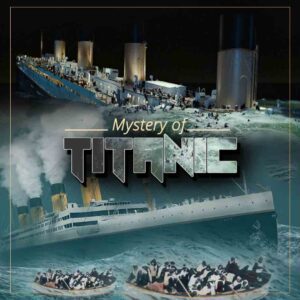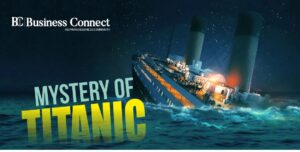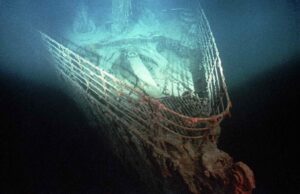Mystery of Titanic Ship Story
How the World’s Greatest Ship Disappeared?
Written By Anurag Tiwari
Titanic Real Story | Titanic Mystery Explained
Greetings, Readers of Business Connect This is the story of 10th April 1912, RMS Titanic ship. Titanic was a real story The world’s largest and most luxurious ship of its time. It was on its maiden voyage. ship was on its way to New York from Southampton, England. & inside sat many people, from big industrialists and actors to immigrants who were going to America for a better life. ship was commanded by Edward John Smith, Senior Captain of Basset.

The public and the media were very excited about the Titanic ship, it was not only the largest ship in the world. It is 269 meters longer than the other and 50 meters higher. In fact, the luxury involved in building it was going to be a great deal. At that time, the cost of making this ship was 7.5 million dollars. If you take inflation into account, that’s $400 million today. facilities and furnishings inside the ship would rival a 5-star hotel.
Stained glass windows and new wood paneling. Two grand staircases. A heated swimming pool, Turkish baths, electric baths, a gym, a squash court, 4 restaurants, 2 barber shops & a library. & because of the way the safety features were used to build the Titanic, ship was deemed unsinkable. It was a ship that can never sink because it is very safe. according to name of the company that built this Titanic ship was White Star Line.
 The vice president of this company was so confident about this & openly said that this ship is unsinkable. But only two days after first trip, on April 12, 1912, Titanic was the first to get its ice warnings. That is the Atlantic Ocean where the ice is rising towards the Titanic America. There are ice -Burks on the top of the big snowy mountains which are dangerous for this Titanic ship. These warnings are not so unusual.
The vice president of this company was so confident about this & openly said that this ship is unsinkable. But only two days after first trip, on April 12, 1912, Titanic was the first to get its ice warnings. That is the Atlantic Ocean where the ice is rising towards the Titanic America. There are ice -Burks on the top of the big snowy mountains which are dangerous for this Titanic ship. These warnings are not so unusual.
The Missing Titanic sub-ship passing through the ocean often communicates with the nearby ships through the radio and tells them that there are many snow in this area of the ocean. Be careful. After receiving these warnings, Titanic changes its course twice to avoid danger but doesn’t reduce its speed. 21 .5 knots which is equivalent to 40 kmph, this ship keeps moving forward in its journey at such a speed. Two days later, on April 14, 1912, seven more ice warnings are given but Captain Smith and his crew leave these warnings.
The titanic’s rafting does not decrease. Gradually, the sun sets & the night falls. the heat falls down. the special thing about this April 14 night is that the moon didn’t come out. Without the moonlight of moon, visibility was very low this night. a small platform on a high height is called a lookout point. It is always kept here by someone so that they keep an eye on what is coming from the titanic ship.
Is there any traffic or obstructions? So, the person who sat on this place has to be very cold. the air was very cold from a very high altitude. It was night and due to the cold air, tears started coming from the eyes. It is even more difficult to see further. It is 11 .49 pm at night. a man named Frederick Fleet is sitting in this crow’s nest. He suddenly sees a big snowy mountain in front of him.
An iceberg has come. He quickly calls the clock three times so that the people sitting below can hear. Then he picks up the phone and calls the officers on the bridge. He screams and says, there is an iceberg in front of us. Quickly turn the ship. The first officers are sitting on the bridge and listening to this instruction. They give the message to the engine room that turn the titanic ship left. But unfortunately, it is very late.
Only after one minute, 11 .40 pm, the ship goes from this iceberg. The time was 11 .40 pm. The iceberg grazed the right side of the ship. & all of a sudden she lifted up quickly. Iceberg was not a small iceberg. It was 200 by 400 feet in length, a football field was as big as it was. And it was reaching the height of a crow’s nest. scientists estimate that the weight of this iceberg was 1 .5 million tons.
This crash with the iceberg took place on the right side of the ship. the titanic ship accident Specifically, it happened near the bow. It was about 10 seconds away from the iceberg and a huge dent was found. Due to this, some small holes in the ship’s main body were also found. You might be wondering how this can be possible.
Mystery of Titanic

The sinking of the titanic is one of the most famous maritime disasters in history. the luxury british passenger liner, often referred to as the “unsinkable ship,” sank on its maiden voyage on April 15, 1912, after colliding with an iceberg in the North Atlantic Ocean. tragedy resulted in the loss of over 1,500 lives.
The disappearance of the Titanic has been a subject of fascination for many, but it’s important to note that the ship itself did not vanish. Instead, it sank to the bottom of the ocean, approximately 2.4 miles (3.8 kilometers) below the surface, where it remained undiscovered for over 70 years.
The exact location of the Titanic’s wreck was unknown until September 1, 1985, when a joint American-French expedition, led by Dr. Robert Ballard, finally located the shipwreck. Using side scan sonar & remote-controlled cameras, they discovered the Titanic ship debris field on the seabed.
The Titanic sank due to a combination of factors. first & foremost, the ship was traveling through an area known for the presence of icebergs, and the crew had received multiple iceberg warnings throughout the day. however, due to a variety of reasons, including miscommunication and overconfidence in the ship’s capabilities, the warnings were not adequately heeded.
When the Titanic ship struck the iceberg, the hull of the ship was punctured, causing it to flood with water. the ship’s design, specifically the lack of a complete watertight compartment system and inadequate lifeboat capacity, contributed to rapid sinking. the ship ultimately broke apart & sank over the course of a few hours.
The sinking of the Titanic had a profound impact on maritime safety regulations. It led to significant improvements in shipbuilding practices, such as the requirement for sufficient lifeboat capacity for all passengers and crew, mandatory 24-hour radio communication on passenger ships, & the establishment of the International Ice Patrol to monitor icebergs in the North Atlantic.
the mystery of titanic ship did not mysteriously disappear but sank to the ocean floor after colliding with an iceberg. the tragedy was a result of a combination of factors, including inadequate precautions, design flaws & the harsh conditions of the North Atlantic.
Add Business Connect magazine to your Google News feed
FAQ
1. What happened to titanic ship? where titanic ship sank?
Titanic ship sank after hitting an iceberg on its maiden voyage in 1912, resulting in loss of over 1,500 lives. It now rests at the bottom of the North Atlantic Ocean.
2. why titanic ship is not taken out?
Titanic ship has not been raised from its resting place on the ocean floor primarily due to the immense depth and challenging conditions of the wreck site, making it technically and logistically difficult to undertake such a large-scale operation. Additionally, the Titanic is now considered a memorial and protected under international agreements.
3. who tell the story of Titanic?
story of Titanic has been told by various sources, including survivors who recounted their experiences, historical records, investigations, books, documentaries, films, & other source forms of media. the story has been passed down through eye-witness accounts, official reports, & extensive research conducted by historians, journalists, & enthusiasts.
4. How much deep titanic sank?
Titanic sank to a depth of approximately 12,415 feet (3,784 meters) below the surface of north atlantic ocean.
5. how titanic ship crash?
Titanic collided with an iceberg on the night of April 14, 1912. iceberg scraped along the starboard side of the ship, causing multiple punctures in the hull below the waterline. the impact caused significant damage, leading to the flooding of several compartments and ultimately resulting in the sinking of the ship.
6. why did the titanic sink if it was unsinkable?
A passenger liner that sank on its maiden voyage in April 1912, was often referred to as “unsinkable” due to its advanced design and safety features. however a combination of factors led to its tragic sinking:
Collision with an iceberg: The primary cause of the Titanic’s sinking was its collision with an iceberg. despite receiving multiple warnings about ice in the area, the ship was traveling at a high speed and failed to alter its course adequately. the iceberg tore holes in the ship’s hull, leading to flooding.
Insufficient number of lifeboats: Although the Titanic had a capacity for over 2,200 passengers & crew, it only carried enough lifeboats for about half that number. this meant that many people were left without life-saving equipment & could not evacuate the ship safely.
Design and construction flaws: Titanic’s builders believed that the ship was virtually unsinkable due to its watertight compartments. however, the compartments did not extend high enough, allowing water to spill over from one compartment to another. This resulted in the flooding of multiple compartments & a loss of buoyancy.
Inadequate safety regulations: at the time of the Titanic’s sinking, maritime safety regulations were not as strict as they are today. There were no mandatory requirements for the number of lifeboats based on a ship’s passenger capacity. the disaster prompted significant changes in safety regulations and led to the establishment of the International Convention for the Safety of Life at Sea (SOLAS) in 1914.
despite being deemed “unsinkable,” a combination of human error, design flaws, and inadequate safety measures led to the tragic sinking of the Titanic. the disaster had a profound impact on maritime safety practices & continues to be remembered as one of the deadliest maritime accidents in history.
7. 10 Unbelievable facts about Titanic?
Certainly! Here are 10 fascinating & unbelievable facts about the Titanic:
1. Size and luxury: Titanic was one of the largest and most luxurious ships of its time. It measured about 882.5 feet long and had nine decks. it featured opulent amenities, including a swimming pool, Turkish bath, gymnasium, & even a squash court.
2. Highspeed claims: Titanic was designed to be a fast ship. It was capable of reaching speeds of up to 23-24 knots (around 27-28 mph), which was considered impressive for a vessel of its size.
3. Costly ticket prices: cost of a ticket on the Titanic varied based on the class of accommodation. First-class tickets could cost up to $4,350 (equivalent to around $105,000 today), which was an enormous sum at the time.
4. Maiden voyage: Titanic’s ill-fated maiden voyage began on April 10, 1912, from Southampton, England, with stops scheduled in Cherbourg, France, & Queenstown, Ireland, before heading to New York City.
5. Radio mishap: wireless radio operators on Titanic received numerous iceberg warnings on the day of the collision. however, a backlog of personal messages from passengers delayed the delivery of these crucial messages to the bridge, contributing to the disaster.
6. Shortage of lifeboats: Despite its size, the Titanic only carried 20 lifeboats, which were enough to accommodate around 1,178 people, less than half of its total capacity of over 2,200 passengers and crew.
7. Band playing until the end: The ship’s band, led by Wallace Hartley, continued to play music even as the Titanic was sinking. They played to keep the passengers calm and provide a sense of order amidst the chaos.
8. Marconi wireless distress signal: Titanic sent out distress signals using its state-of-the-art Marconi wireless system. The signals were picked up by nearby ships, including the RMS Carpathia, which came to the rescue and saved over 700 survivors.
9. Unsinkable claims: “unsinkable” label for the Titanic came from advertisements and popular belief surrounding its advanced safety features. However, these claims were proven tragically wrong when the ship sank on its maiden voyage.
10. Underwater discovery: wreckage of the Titanic was discovered by a team led by Dr. Robert Ballard in 1985, almost 73 years after its sinking. The ship’s remains rest about 12,500 feet below the surface of the Atlantic Ocean.
These facts highlight the grandeur, tragedy, and historical significance of the Titanic.
Must Read
- Top 5 Indian Cities with Highest Startup Funding
- Top 10 Adorable Gifts for Your Special One
- Top 10 Countries with Maximum Indian Population as Citizens
- Top 10 highest paid CEO in the World
- Top 10 richest person of India
- Top 10 Highest Paid CEOs of India
- The Success Story of Jeff Bezos
- Success Story Of Elon Musk
- Top 10 Business Newspaper In India
- Top 10 Tourist Places in India, places to visit after lockdown



